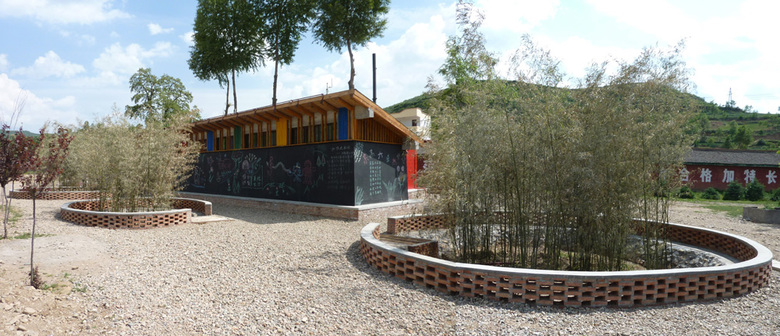Split Bathhouse
Shanmen, 中国
BaO collaborated with Madaifu, an association working with children in difficult familial situations in Gansu province. Shanmen primary and secondary schools asked us to help them build a bathhouse that could be used by the 700 school kids to prevent disease spreading and improve overall sanitary situation. The bathhouse is used by the schools during the week and by the villagers during the weekends (more than 5000 inhabitants in the vicinity).
Shanmen is one of these villages, wedged far in the mountain, transforming rapidly and modernizing its infrastructures. Earth traditional houses are being replaced by squared brick blocks with white tiled facades and blue-tinted windows aggregating along the new roads, cluster of neatly aligned new style village houses appear, few multistory buildings are erected there and there, etc... Nevertheless, no public equipments, no public spaces or community facilities is being implemented. The split bathhouse was thus envisaged as a reaffirmation of public services as core programs for development and as an investigation into alternative building technologies in the countryside.
The project is split in a very straightforward way into two distinct bathing buildings, one for men and one for women. These two wings are joined by an open, half inside half outside collective greenhouse. The building is thus performing as a basic sanitation facility while also proposing the creation of a social infrastructure. Our intention of creating public spaces all around and in-between what had to be, by definition, a highly intimate program resulted in treating the two bathing aisles as introverted "black blocks" in full contrast with the shared greenhouse that is transparent and open on both sides. The two inverted blocks contain the cloakrooms shower spaces, technical, management rooms, and dry toilets. Roofs are tilted outward to bring natural light through a continuous windows strip and shower spaces are shifted sideways in plan to permit natural cross-ventilation. In order for the blind facades of the buildings to be active and playful assets in the project, we decided to treat the whole building into a gigantic blackboard. School children can draw on, write on, play with, play on the bathhouse and transform its facade day after day.
Since neither public water supply nor drainage systems were existing, the whole bathhouse had to be designed as a sustainable autonomous entity. After being pumped from underground, the water is stored in a 20m3 tank that supplies the boiler or the 100m2 of solar water heating panels of the bathhouse. After being heated and used in the showers and the washbasins, the waste water exits the building to reach a series of bamboo planted basins that treat and purify the waste-water with a natural process (phyto-filtration). A total of 5 of those round shape filtration plants surround the bathhouse and encircled by brick seating permitting villagers to gather around the buildings.











